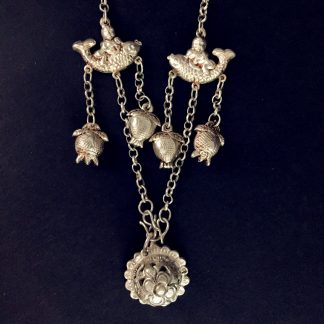Silver
“蛾儿雪柳黄金缕,笑语盈盈暗香去。众里寻他千百度,蓦然回首,那人却在灯火阑珊处。”
The lantern festival girls pass in a graceful glitter of laughter and jewellery. Searching the multitudinous crowd, suddenly looking back he finds her waiting in the waning light.
Silver wares evolved over thousands of years amongst the Qiang, Miao and Tibetan minority peoples in southwest China – see our Stories. The designs are inspired by the natural environment, mountains, rivers, trees and wildlife.
The mountainous area, still remote today, was historically connected to the outside world only by the “Tea horse road” a network of narrow paths winding through the mountains of Sichuan, Yunnan and Guizhou in Southwest China, barely wide enough for a horse in many places. The silver is mined in the LongMen “Dragon Gate” mountain range in Mao county in Ngawa Tibetan/Qiang autonomous prefecture in northwest Sichuan, which was also the centre of the 2008 Sichuan earthquake.
Traditional Craftspeople use Fine 99.9% pure silver both for its softness and the cultural value of pure silver. By contrast Sterling silver is defined as only 92.5% purity.
Pure Silver is traditionally valued for medical purposes, both to prevent disease, and to purify boiling water. This isn’t just superstition: Silver has been proven in modern times to be anti-bacterial, anti-microbial, anti-viral, and anti-fungal and is now used by NASA in space as well as water treatment systems on earth.
Showing all 10 results
-
Ceramic Earrings kiss ears 1
 Kiss Your Ears. — This winter, you ears will no longer feel lonely. Handmade ceramic jewelries, designed by Wang Fei 王飞. This series of ceramic jewelries have been selected to participate in 2017’s designer exhibition in London. Size of white ceramic part: 1.8 cm * 0.3 cm Length of the whole earring: 1.8 cm Weight of the earrings: 0.85 grams…$39.70 (USD)
Kiss Your Ears. — This winter, you ears will no longer feel lonely. Handmade ceramic jewelries, designed by Wang Fei 王飞. This series of ceramic jewelries have been selected to participate in 2017’s designer exhibition in London. Size of white ceramic part: 1.8 cm * 0.3 cm Length of the whole earring: 1.8 cm Weight of the earrings: 0.85 grams…$39.70 (USD)
Shipping size: 5 × 5.5 × 4 cm
Shipping weight: 30 g


Ceramic Earrings kiss ears 1
$39.70 (USD) Add -
Ceramic Earrings Kissing Ears 2



Shipping size: 5 × 5.5 × 4 cm
Shipping weight: 80 g


Ceramic Earrings Kissing Ears 2
$39.70 (USD) Add -
Ceramic Earrings Kissing Ears 3



Shipping size: 5 × 5.5 × 4 cm
Shipping weight: 80 g


Ceramic Earrings Kissing Ears 3
$39.70 (USD) Add -
Ceramic Earrings Kissing Ears 4



Shipping size: 5 × 5.5 × 4 cm
Shipping weight: 80 g


Ceramic Earrings Kissing Ears 4
$39.70 (USD) Add -
Ceramic Earrings Kissing Ears 5



Shipping size: 5 × 5.5 × 4 cm
Shipping weight: 80 g


Ceramic Earrings Kissing Ears 5
$39.70 (USD) Add -
Handmade Qiang silver necklace and lucky charm






Handmade Qiang silver necklace and lucky charm
$198.04 (USD) Add -
Handmade Qiang Silver Necklace with fish and flower charms






Handmade Qiang Silver Necklace with fish and flower charms
$145.43 (USD) Add -
Qiang Silver Hair Brooch






Qiang Silver Hair Brooch
$197.89 (USD) Add -
Silver Butterfly Earrings (double layers)



Brand: inkston


Silver Butterfly Earrings (double layers)
$92.11 (USD) Choose -
Silver Lion Earring (long bell)






Silver Lion Earring (long bell)
$68.60 (USD) Add
Showing all 10 results
